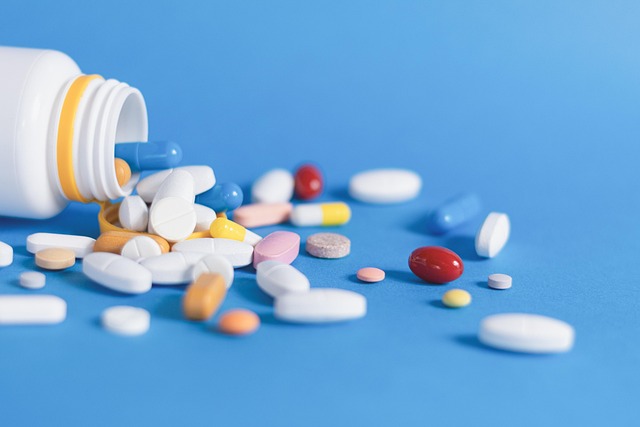GLP-1 receptor agonists (GLP-1 drugs) are medications that mimic natural hormone GLP-1, revolutionizing type 2 diabetes management. They enhance insulin secretion based on blood glucose levels and suppress glucagon release, improving glycemic control. These drugs increase insulin sensitivity, promote weight loss, and reduce cardiovascular risks, offering a more natural approach compared to traditional insulin injections. While initial side effects like nausea may occur, GLP-1 drugs are generally safe with low risk of hypoglycemia or severe complications. Effective management includes balanced diet, regular exercise, patient education, and close monitoring by healthcare providers. Long-term use shows promise in improving glycemic control, weight reduction, and blood pressure lowering, with ongoing research exploring their potential to mitigate diabetes-related complications and enhance cardiovascular health.
“GLP-1 receptor agonists (GLP-1 drugs) have emerged as powerful tools in diabetes management, offering significant advantages for patients. This comprehensive guide explores the science behind these innovative therapies, their remarkable ability to lower blood sugar levels, and their positive impact on insulin regulation. From improving insulin sensitivity to potential cardiovascular benefits, we delve into the multifaceted role of GLP-1 drugs. Moreover, this article provides insights into managing side effects and integrating these treatments into daily life, highlighting their long-term potential in diabetes care.”
Understanding GLP-1 Receptor Agonists: Their Role in Diabetes

GLP-1 receptor agonists are a class of medications that mimic the effects of the natural hormone glucagon-like peptide-1 (GLP-1). They play a significant role in diabetes management, particularly in type 2 diabetes. These drugs work by stimulating insulin secretion in response to blood glucose levels, which helps lower blood sugar. In addition, GLP-1 drugs suppress the release of glucagon, a hormone that raises blood sugar, further contributing to improved glycemic control.
By activating GLP-1 receptors in the pancreas and brain, these agonists enhance insulin sensitivity and promote weight loss, making them versatile tools in diabetes treatment. They offer a more natural approach compared to traditional insulin injections, providing better blood sugar control while also aiding in managing weight, a common challenge for individuals with diabetes.
How GLP-1 Drugs Lower Blood Sugar Levels

GLP-1 receptor agonists, or GLP-1 drugs, play a pivotal role in diabetes management by mimicking the effects of the natural hormone glucagon-like peptide-1 (GLP-1). These medications stimulate insulin secretion in a glucose-dependent manner, meaning they promote the release of insulin only when blood sugar levels are high. This targeted approach helps lower blood sugar effectively.
Additionally, GLP-1 drugs suppress glucagon production, which reduces the amount of glucose released by the liver. By balancing these hormones, these drugs provide a dual mechanism to control blood sugar. The result is improved glycemic control, offering significant benefits for individuals with diabetes in managing their condition and reducing the risk of associated complications.
The Impact on Insulin Secretion and Sensitivity

GLP-1 receptor agonists, a class of medications often referred to as GLP-1 drugs, significantly enhance insulin secretion in response to meals. This effect is particularly notable for its ability to stimulate beta cells in the pancreas to release insulin, thereby improving glycemic control. The mechanism involves the activation of GLP-1 receptors, which play a crucial role in regulating blood sugar levels. By mimicking the natural actions of GLP-1, these drugs not only increase insulin production but also enhance insulin sensitivity in peripheral tissues, contributing to better glucose metabolism and reduced blood sugar spikes after meals.
Furthermore, GLP-1 drugs can reduce glucagon secretion, a hormone that raises blood sugar. This dual action—boosting insulin while inhibiting glucagon—makes them effective tools in diabetes management. The impact on both insulin secretion and sensitivity translates into improved overall glycemic control, offering a significant advantage for individuals with type 2 diabetes who often struggle to maintain stable blood sugar levels through lifestyle adjustments alone.
Beyond Blood Sugar Control: Other Health Benefits

While GLP-1 receptor agonists are primarily known for their role in blood sugar control, these innovative GLP-1 drugs offer a wide array of additional health benefits that extend far beyond diabetes management. Studies have shown that these medications can help reduce cardiovascular risks by lowering blood pressure and improving cholesterol levels. Moreover, they have been linked to weight loss and appetite regulation, making them potential tools in the fight against obesity and its associated complications.
The positive effects of GLP-1 drugs don’t stop there. They also exhibit anti-inflammatory properties, which can play a crucial role in mitigating long-term diabetes complications such as nerve damage and kidney disease. Additionally, some GLP-1 agonists have been shown to enhance bone density, reducing the risk of osteoporosis—a common concern for people with diabetes. These multifaceted benefits highlight the significant role these drugs can play in overall health and wellness for individuals living with diabetes.
Minimizing Side Effects: What to Expect with GLP-1 Drugs

GLP-1 receptor agonists, or GLP-1 drugs, are known for their remarkable benefits in diabetes management, but it’s also important to understand that like any medication, they come with potential side effects. However, rest assured that these drugs have been designed to minimize discomfort and maximize patient safety. The most common side effects are typically mild and temporary, including nausea, vomiting, diarrhea, stomach pain, or constipation. These gastrointestinal symptoms often occur as the body adjusts to the new medication but usually subside within a few weeks.
Unlike some other diabetes medications, GLP-1 drugs have a low risk of hypoglycemia (low blood sugar), making them a safer option for many patients. In rare cases, more severe side effects may include pancreatitis or kidney problems, but these risks are significantly lower compared to other treatments. Regular monitoring by healthcare professionals can help manage any potential issues and ensure the best possible experience with GLP-1 drugs.
Lifestyle Considerations When Taking GLP-1 Agonists

When incorporating GLP-1 receptor agonists into diabetes management, lifestyle considerations are paramount to maximize benefits and minimize potential side effects. Diet plays a crucial role; a balanced, low-carb diet can enhance the effectivity of these drugs by helping to regulate blood sugar levels. Regular exercise is also essential, as physical activity, particularly after meals, improves insulin sensitivity and glucose control.
Additionally, staying hydrated is vital, as GLP-1 drugs may suppress appetite, potentially leading to dehydration if fluid intake isn’t adequate. Patient education on these medications’ actions and potential impacts is key, encouraging informed decisions about diet and exercise routines. Close monitoring of blood sugar levels by patients, in collaboration with healthcare providers, ensures safe and effective use of GLP-1 drugs.
Long-Term Use and Management Strategies

The long-term use of GLP-1 receptor agonists has shown promising results in diabetes management. These drugs, often referred to as GLP-1 drugs, have been designed to mimic the effects of the natural hormone GLP-1, which stimulates insulin production and suppresses glucagon secretion. Over time, they can help improve glycemic control, reduce body weight, and lower blood pressure—all vital aspects for diabetes management.
Management strategies for long-term use include patient education on medication adherence, regular monitoring of blood sugar levels, and lifestyle modifications such as a balanced diet and regular exercise. Additionally, healthcare providers should consider individual patient factors, like the specific type of GLP-1 drug prescribed and potential side effects, to ensure optimal treatment outcomes.
Future Prospects and Research in GLP-1 Receptor Agônist Therapy

As research progresses, the future prospects for GLP-1 receptor agonists in diabetes management look promising. Ongoing studies are exploring their potential to slow the progression of diabetic complications, such as kidney and eye damage. Additionally, researchers are investigating the role of these drugs in cardiovascular health, given emerging evidence suggesting their beneficial effects on heart function and blood pressure.
The next generation of GLP-1 drugs is also a focus, with scientists working on improving their efficacy, duration of action, and ease of administration. This includes developing long-acting injectables and even oral formulations, aiming to enhance patient compliance and quality of life. Moreover, combining GLP-1 therapy with other diabetes treatments or using it in conjunction with weight management programs is an area of active investigation, seeking to optimise blood glucose control and promote overall health.
